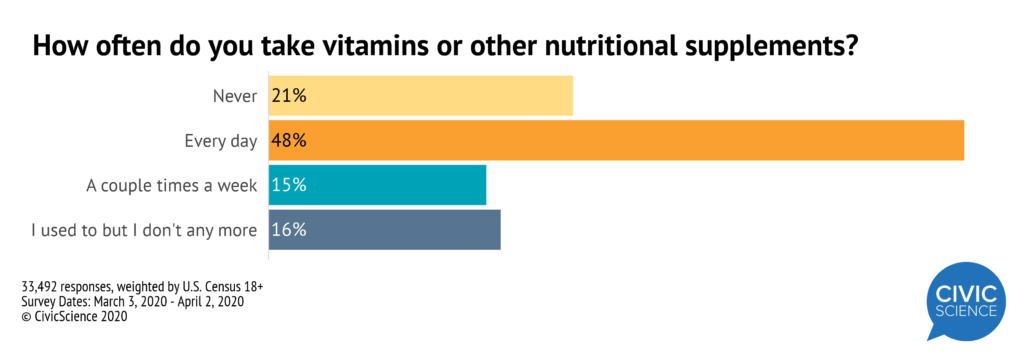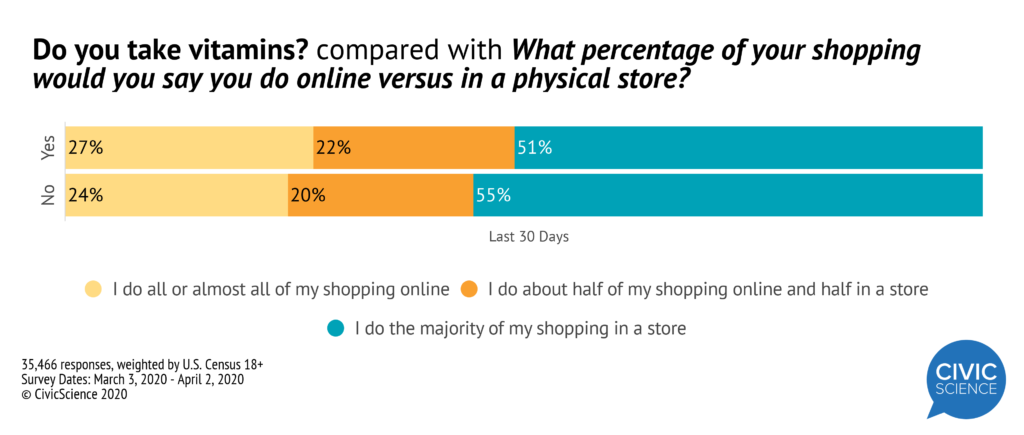The vitamin and supplement industry is booming. Despite debate over health claims, it’s estimated that American adults spend upwards of $12 billion per year on vitamins and supplements.
And according to recent findings from CivicScience, that doesn’t appear to be slowing down any time soon.
A survey of more than 33,000 U.S. adults found that 63% of Americans regularly take vitamins and other nutritional supplements. What’s more, close to half take them every day. In fact, the number of daily vitamin takers rose 14% (from 43% to 49%) between February and March alone.
In fact, the number of daily vitamin takers rose 14% (from 43% to 49%) between February and March alone.
In addition, those who say they never take vitamins or supplements fell sharply from 25% to 21% in the same time frame.
COVID-19 and Rise in Vitamin Usage
Vitamin users typically index as more health-conscious overall. They’re more likely to buy organic groceries, eat less fast food, exercise more, and take more trips to the doctor.
Yet it’s pretty safe to assume that with the COVID-19 health crisis, more people are turning to vitamins and supplements to try and stay healthy and boost immune function. Based on the growth trend, it appears to be converting some of those who never take vitamins into daily users.
And that growth isn’t just among older adults. While Baby Boomers are overall the biggest users of vitamins and supplements (62% now say they take them every day), the increase in daily usage witnessed in March spans all age groups, with the exception of 18- to 24-year-olds, leading to today’s current numbers:
 When it comes to purchasing, the survey doesn’t indicate that vitamin users are spending more right now overall. The data do show that vitamin users are overall more likely to shop online than non-users. And among Baby Boomers, those who take vitamins daily are more likely to be Amazon Prime members.
When it comes to purchasing, the survey doesn’t indicate that vitamin users are spending more right now overall. The data do show that vitamin users are overall more likely to shop online than non-users. And among Baby Boomers, those who take vitamins daily are more likely to be Amazon Prime members. 
News and Vitamin Use
News and how people receive health information may play a role in vitamin usage over the next several weeks. Consider the highly-debated topic that Vitamin C can be used to treat COVID-19 infection, which some hospitals are now doing.
At the moment, vitamin users and non-vitamin users are receiving the majority of coronavirus-related news online. Vitamins users are more likely than non-vitamin users to use channels other than the internet, most notably TV. Radio and social media factor in for vitamin users, but to a lesser extent. However, vitamin users are more likely to get news from social media compared to non-users.
 And non-vitamin users are more likely than vitamin users to say they do not follow any news about the coronavirus.
And non-vitamin users are more likely than vitamin users to say they do not follow any news about the coronavirus.
In the months ahead, time will tell whether or not daily usage will sustain current levels, continue to climb, or fall off to pre-coronavirus levels.








